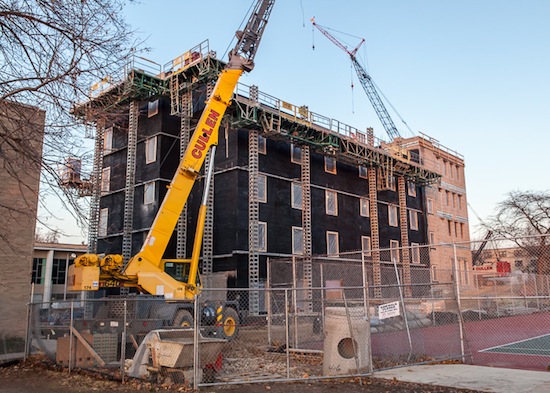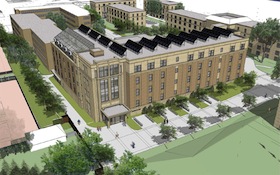New residence hall, with an environmental theme, rises on lakeshore

Construction continues on the campus’ newest residence hall, temporarily named New 32.
Photo: University Housing
A new $17.3 million residence hall, temporarily named New 32 Hall, will be ready to house more than 170 students next fall.
The temporary name for the building comes from the parking lot that was removed to make way for the residence hall, Lot 32.
A permanent name reflecting the hall’s conservation and sustainability theme will be chosen next year, says Brendon Dybdahl, University Housing director of marketing and communications.
The building is located in the campus’ Lakeshore area between Cole Hall and Holt Commons.
The roof has been built over the structure, and work on the interior of the building will continue through the winter. Construction is due for completion next summer. People can view the construction as it progresses via a live webcam here.
The fourth floor of New 32 will be designated as the campus’ new GreenHouse residential learning community, replacing the facility at Cole Hall. A working greenhouse is planned for the roof, giving students hands-on sustainability lessons. GreenHouse is one of nine learning communities on campus.

This rendering shows how the finished building, with its rooftop solar panels, will look.
The capacity of the new residence hall will be 172 beds, significantly smaller than the recently opened Dejope Residence Hall, which houses 408 students.
The layout of the four-story building is patterned after the university’s other newer residence halls, Dejope, Smith and Ogg. Rooms will be grouped in clusters, with restroom and shower facilities shared by 10 residents.
The four main floors of New 32 will be residential, each with a kitchenette. The lower level will have a larger kitchen area, a hall lounge, programming space, laundry, offices and a classroom.
The exterior will be light colored brick. The building when finished will encompass 64,500 square feet, 42,211 square feet of which will be assignable as residences for students. Its design incorporates a number of energy-saving features, including rooftop solar panels for water heating.
New 32 is the last in a series of new buildings that have been part of University Housing’s 2004-20 Master Plan. The addition of New 32 brings the number of beds available at UW–Madison residence halls to about 7,400.
The university’s housing goal is to have enough space to accommodate any incoming freshmen and upperclassmen who choose to live in University Housing, and this addition brings the university closer to that goal, Dybdahl says.

